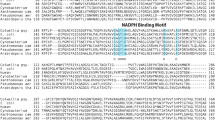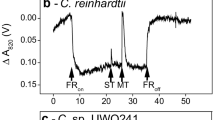Abstract
A psychrophilic glutathione reductase from Antarctic ice microalgae Chlamydomonas sp. Strain ICE-L was purified by ammonium sulfate fractionation and three steps of chromatography. The yield was up to 25.1% of total glutathione reductase in the crude enzyme extract. The glutathione reductase activity was characterized by the spectrophotometric method under different conditions. Purified glutathione reductase was separated by SDS-PAGE, which furnished a homogeneous band. The native molecular mass of the enzyme was 115 kDa. Apparent Km values for NADPH and NADH (both at 0.5 mmol L−1 oxidized glutathione) were 22.3 and 83.8 μmol L−1, respectively. It was optimally active at pH 7.5, and it was stable from pH 5 to 9. Its optimum temperature was 25°C, with activity at 0°C 23.5% of the maximum. Its optimum ion strength and optimum Mg2+ were 50–90 and 7.5 mmol L−1, respectively. Ca2+, Mg2+, and cysteine substantially increased the activity of the enzyme but chelating agents, heavy metals (Cd2+, Pb2+, Cu2+, Zn2+, etc.), NADPH, and ADP had significant inhibitory effects. This glutathione reductase can be used to study the adaptation and mechanism of catalysis of psychrophilic enzymes, and it has a high potential as an environmental biochemical indicator under extreme conditions.







Similar content being viewed by others
Abbreviations
- DTT:
-
Dithiothreitol
- EGTA:
-
1,2-Di-(2-aminoethoxy)ethane-N,N,N′,N′-tetraaetic acid
- GR:
-
Glutathione reductase
- GSH:
-
Reduced glutathione
- GSSG:
-
Oxidized glutathione
- NEM:
-
N-ethylmaleimide
- PVP:
-
Polyvinylpyrrolidone
- SDS:
-
Sodium dodecyl sulfate
References
Aono M, Kubo A, Saji H, Tanaka K (1993) Enhanced tolerance to photo-oxidative stress of transgenic Nicotiana tabacum with high chloroplastic glutathione reductase activity. Plant Cell Physiol 34:129–135
Baek KH, Skinner DZ (2003) Alteration of antioxidant enzyme gene expression during cold acclimation of near-isogenic wheat lines. Plant Sci 165:1221–1227
Bradford MM (1976) A rapid and sensitive method for the quantitation of microgram quantities of protein utilizing the principle of protein-dye binding. Anal Biochem 72:248–254
Ding Y, Miao JL, Wang QF, Li GY (2005) Effect of Cd on GSH and GSH-related enzymes of Chlamydomonas sp. ICE-L existing in Antarctic ice. J Environ Sci 17(4):667–671
Ding Y, Miao JL, Wang QF, Kan GF, Zheng Z, Li GY (2006) The temperature effect on GSH and GSH-related enzymes of Antarctic ice microalgae ICE-L (Chlamydomonas sp. ICE-L) (in Chinese). Oceanogr limnol 37(2):154–161
Foyer CH, Souriau N, Perret S, Lelandais M, Kunert KJ, Pruvost C, Jouanin L (1995) Overexpression of glutathione reductase but not glutathione synthetase leads to increases in antioxidant capacity and resistance to photoinhibition in poplar trees. Plant Physiol 109:1047–1057
Gratão PL, Andrea Polle, Lea PJ, Azevedo RA (2005) Making the life of heavy metal-stressed plants a little easier. Funct Plant Biol 32:481–494
Guo LH, Chen S, Gong M (1999) Comparison of methods for glutathione reductase activity assays in maize seedlings. J Yunnan University (China) 21(5):416–418
Gutterer JM, Ralf D, Johannes H (1999) Purification of glutathione reductase from bovine brain, generation of an antiserum, and immunocytochemical localization of the enzyme in neural cells. J Neurochem 73(4):1422–1430
Hakam N, Simon JP (2000) Molecular forms and thermal and kinetic properties of purified glutathione reductase from two populations of barnyard grass. Can J Bio L 78:969–980
Halliwell B, Foyer CH (1978) Properties and physiological function of glutathione reductase purified from spinach leaves by affinity chromatography. Planta 139:9–17
Huston AL, Krieger-Brockett BB, Deming JW (2000) Remarkably low temperature optima for extracellular enzyme activity from Arctic bacteria and sea ice. Environ Microbiol 4:383–388
Kalt-Torres W, Burke JJ, Anderson JM (1984) Chloroplast glutathione reductase: purification and properties. Physiol Plant 61:271–278
Kocsy G, Toth B, Berzy T (2001) Glutathione reductase activity and chilling tolerance are induced by a hydroxylamine derivative BRX-156 in maize and soybean. Plant Sci 160:943–950
Kouřil R, Lazár D, Lee H, Nauš J (2003) Moderately elevated temperature eliminates resistance of rice plants with enhanced expression of glutathione reductase to intensive photooxidative stress. Photosynthetica 41(4):571–578
Laemmli BK (1970) Cleavage of structural proteins during the assembly of the head of bacteriophage T4. Nature 223:680–685
Lascano HR, Casano LM, Melchiorre MN (2001) Biochemical and molecular characterization of wheat chloroplastic glutathione reductase. Biologia Plantarum 44(4):509–516
Leipner J, Fracheboud Y, Stamp P (1999) Effect of growing season on the photosynthetic apparatus and leaf antioxidative defenses in two maize genotypes of different chilling tolerance.Environ Exp Biol 42:129–139
Ondarza RN, Rendón JL, Ondarza M (1983) Glutathione reductase in evolution. J Mol Evol 19(5):371–375
Pais EF, Schulz GE (1983) The catalytic mechanism of glutathione reductase as derived from X-ray diffraction analyses of reaction intermediates. J Bio Chem 258(3):1752–1757
Peinado J, Florindo J, Alfonso CG, Galisteo EM, Llobell A, Barea JL (1991) Metals are directly involved in the redox interconversion of Saccharomyces cerevisiae glutathione reductase. Mol Cell Biochem 101(2):175–187
Provasoli L (1968) Media and prospects for the cultivation of marine algae. In: Watanabe, Hattori A (eds) Cultures and collections. Proceedings of US–Japan conference on Hakone, September 1966. Japanese Society of Plant Physiology, pp 63–75
Rendon JL, Hernandez GM (2001) Unfolding kinetics of glutathione reductase from cyanobacterium Spirulina maxima. Arch Biochem Biophys 87:265–272
Schirmer RH, Krauth-Siegel RL, Schultz GE (1989) Glutathione Reductase. In: Poulson DDR, Avramovic O (eds) Glutathione. Wiley, New York, pp 553–596
Serrano A, Lobell A (1993) Occurrence of two isoforms of glutathione reductase in the green alga Chlamydomonas Reinhardtii. Planta 190:199–205
Serrano A, Rivas J, Losada M (1984) Purification and properties of glutathione reductase from the cyanobacterium Anabaena sp.strain 7119. J Bacteriol 158:317–324
Tanaka K, Sano T, Ishizuka K (1994) Comparison of properties of leaf and root glutathione reductases from spinach. Physiol Plant 91:353–358
Acknowledgments
This work was supported by the Natural Science Foundation of China (NSFC, No. 40206022; No. 40406003).
Author information
Authors and Affiliations
Corresponding author
Rights and permissions
About this article
Cite this article
Ding, Y., Miao, JL., Wang, QF. et al. Purification and characterization of a psychrophilic glutathione reductase from Antarctic ice microalgae Chlamydomonas sp. Strain ICE-L. Polar Biol 31, 23–30 (2007). https://doi.org/10.1007/s00300-007-0328-5
Received:
Revised:
Accepted:
Published:
Issue Date:
DOI: https://doi.org/10.1007/s00300-007-0328-5




